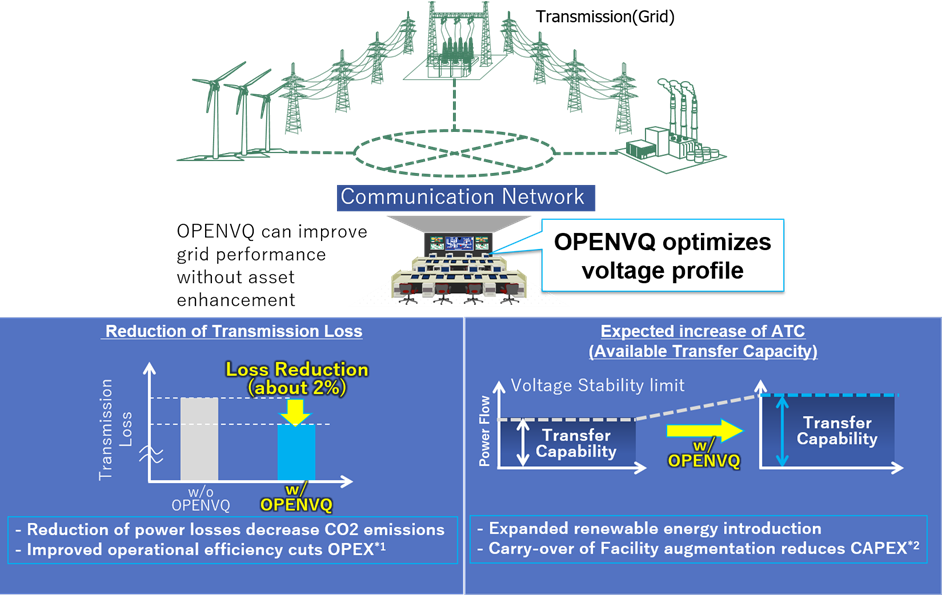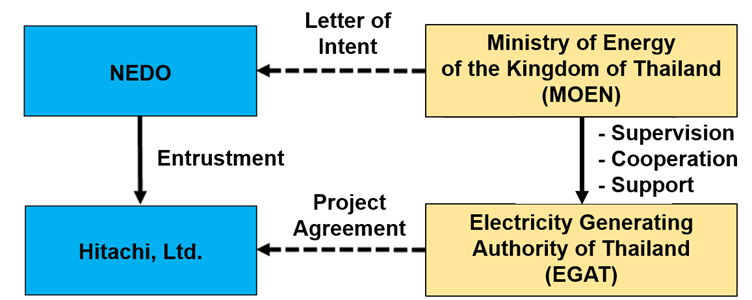Information contained in this news release is current as of the date of the press announcement, but may be subject to change without prior notice.
Thailand’s First Demonstration Project of Optimized Performance Enabling Network for Volt/Var(Q) (OPENVQ) in Power Transmission Networks (PDF Type, 403kByte)![]()
เริ่มดำเนินโครงการสาธิตระบบ OPENVQ ซึ่งเป็นนวัตกรรมการควบคุมแรงดันไฟฟ้าและกำลังไฟฟ้ารีแอคทีฟของระบบส่งไฟฟ้าให้เหมาะสมที่สุดโดยประยุกต์ใช้เทคโนโลยีการสื่อสารและสารสนเทศ ครั้งแรกในประเทศไทย (PDF Type, 232kByte)![]()
January 12, 2021
Thailand’s First Demonstration Project of Optimized Performance Enabling Network for Volt/Var(Q) (OPENVQ) in Power Transmission Networks
– Aiming to reduce greenhouse gas emissions through more advanced and efficient power system operations –
New Energy and Industrial Technology Development Organization (NEDO) Hitachi, Ltd., January 12, 2021– New Energy and Industrial Technology Development Organization (NEDO) and the Ministry of Energy of the Kingdom of Thailand (MOEN) exchanged letters of intent (LOI) to carry out a demonstration project with the aim of achieving low carbonization and enhancements in power system operations. Based on the LOI, Hitachi, Ltd. (Hitachi), the consignee of the project, and the Electricity Generating Authority of Thailand (EGAT) commenced the demonstration project of optimized performance enabling network for volt/var(Q) (OPENVQ) in December.
Introducing OPENVQ in EGAT’s transmission network, this project aims to reduce greenhouse gas emissions through more sophisticated and more efficient power system operations. This project also seeks to quantify the reduction of greenhouse gas emissions through the bilateral Joint Crediting Mechanism (JCM).

Fig. 1 Overall picture of the demonstration system and expected effects
-
Demonstration Project Overview
Electricity demand in Thailand is growing as its economy develops, and the country is now faced with a challenge to reduce the loss of power in the transmission network (hereinafter called “power losses”). In addition, with the amount of fossil fuels, such as natural gas, also rising because electricity is generated mainly by thermal power plants in Thailand, the country needs to introduce renewable energy to create a power source mix that could mitigate environmental impacts.Under these circumstances, there is a plan for terminating the operation of some thermal power plants partly due to facility deterioration in northeastern Thailand, the area in which the demonstration project will be carried out, after 2025. Then, the purchase of electricity from neighboring countries and construction of new power generation facilities, such as hydroelectric power plants and/or photovoltaics (PV), are being considered as alternatives. To realize electricity supply through such multiple generations, transmission facilities should be expanded and reinforced for increasing an available transfer capability. However, not much progress has been made in that plan because significant investments are required. Moreover, EGAT has been faced with a challenge of dealing with the difficulty of supplying electricity stably while reducing power losses because no technology for voltage optimization has been installed in the current transmission network with various power sources connected.
Against this background, NEDO and MOEN agreed to implement a demonstration project for the purpose of low carbonization and enhancements in power system operation, exchanging Letters of Intent for cooperation. In parallel, Hitachi, the consignee of the demonstration project*3 and Electricity Generating Authority of Thailand (EGAT), a state-owned electric power company that undertakes power generation and transmission in Thailand, concluded a Project Agreement.
Following the conclusion of these agreements, NEDO in collaboration with these partner companies started the demonstration project of the OPENVQ, an online-based optimal voltage/reactive power control system, in the power transmission system owned by EGAT in northeastern Thailand in December.
This demonstration project will install OPENVQ on EGAT’s transmission network to reduce power losses through more advanced and more efficient operation of electric power systems, seeking to reduce greenhouse gas emissions. In parallel, it will seek the quantification of greenhouse gas emission reduction through the Joint Crediting Mechanism*4 (JCM).
-
Details of the demonstration project
The OPENVQ system introduced in the demonstration project forecasts the future power flow and supply-demand balance by using facility and measurement data in the transmission network obtained from the grid control system and by combining such data with power generation plans and weather forecasts. Then, optimally controlling voltages and reactive power online while securing voltage stability, it will make power system operation more sophisticated and efficient, leading to the reduction of power loss.In this demonstration project, OPENVQ will be linked with SCADA*5 being used in the regional control center operated by EGAT to optimize voltages and reactive power in the transmission network in pursuit of reduction of power losses by utilizing measurement data, a highly accurate demand forecasting technology and very reliable optimal current calculations.
This will contribute to cutting down on the fuel procurement cost at thermal power plants through reduction of power losses and trimming CO2 emissions from power system operation. In addition, with the available transfer capability expected to increase through voltage optimization in the grid, stable power supply from renewable energy will become possible without a large amount of investment in the augmentation of power transmission facilities, which is expected to contribute to the expansion of renewable energy adoption in Thailand. Furthermore, by applying the MRV methodology*6 in JCM, the reduction of CO2 emissions will be evaluated in this demonstration project, which will lead to issuance of JCM credits and show the contribution of Japan to global warming measures in Thailand. By reducing power losses, CO2 emissions are expected to be decreased by 10,000 to 20,000 tons*7 per year through this project.
Based on the analysis and evaluation results of this demonstration project, Hitachi will feature OPENVQ as its differentiating technology in pursuit of the possibility of applying the technology to the global market with a focus on Asian market, including ASEAN countries faced with challenges similar to Thailand’s.
-
Implementation structure of the demonstration project
Consignee: Hitachi, Ltd
Company responsible for the demonstration site: Electricity Generating Authority of Thailand Demonstration site: Electricity transmission grid in Northeastern Thailand operated by Electricity Generating Authority of Thailand
Fig. 2 Implementation structure
——-
*1 OPEX
Stands for operating expenses and refers to expenditures related to the operation of power transmission systems in this demonstration project.
*2 CAPEX
Stands for capital expenditures and refers to spending for physical assets such as transmission system facilities and control equipment in this demonstration project.
*3 Demonstration project
Project name:
Program to Facilitate Private Sector-Led Promotion of Low-Carbon Technology Overseas / Program to Promote Market Creation Using Low-Carbon Technology / Low-Carbonized Operation of a Power Grid Utilizing Online Voltage-var (Q) Optimal Control “OPENVQ” with ICT (Thailand)
*4 Joint Crediting Mechanism (JCM)
A scheme for reducing greenhouse gas emissions in cooperation with JCM partner developing countries, in which the result of reduction is allocated as contribution by both partner countries and Japan.
*5 SCADA
Stands for Supervisory Control And Data Acquisition and refers to a system in which power systems are monitored and controlled through computers.
*6 MRV
Stands for Measurement, Reporting and Verification and refers to the measurement, reporting and verification of greenhouse gas emissions in this demonstration project.
*7 Reduction of CO2 emissions by 10,000 to 20,000 tons per year
Values calculated based on the carbon dioxide emission factors published by the governmental organizations of Thailand.

